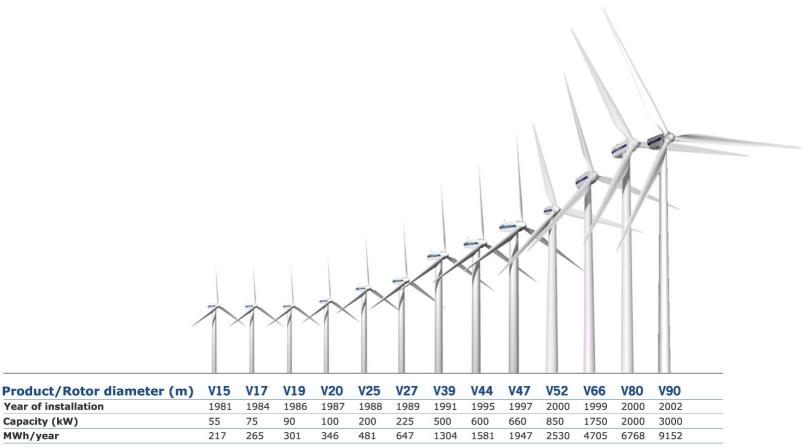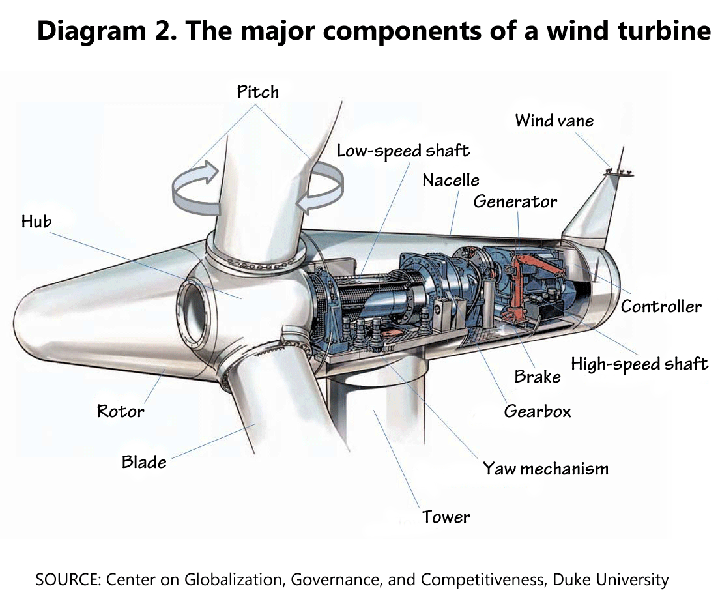To
start this off, we will first explain what wind power is. Wind power is power
derived from wind: used to generate electricity or mechanical power. Wind is
produced by the uneven heating of the Earth’s surface. The movement of air is
from convection currents. Convection current is when warm air rises and cool
air sinks. The cool air then takes the place of the rising warm air. The
process of convection currents is what makes the wind blow.
 |
| Convection current: The transfer of heat by the mass movement of heated particles into an area of cooler fluid |
Wind is the fastest growing renewable source of electricity in the world.
There are
two types of wind turbines: there are some that have rotors that turn on the
vertical axis, and some who rotate horizontally. The most commonly found wind
turbines are the horizontal ones.
Here is the
structure of the wind turbine: The rotor (usually 3 blades) with a shaft behind, a mechanical drive
train, and an electrical generator are all on top of the tower. "The
height of the tower is normally at least twice the length of the blade. The
blades need to be far enough from the ground to minimize turbulence and to
maximize the energy capture of the wind turbine" (Northern Ireland Planning Portal). The turbines also have an interior computer system that
controls it. The computer system within the turbine must align the turbine with
the wind.
 |
| Components of a wind turbine |
A
wind turbine today uses the flow of air to generate electricity. Before any
electricity is made, it goes back to the turbines. Blowing air passes around
both sides of the turbines blade. The shape of the blade causes the air
pressure to be uneven; making it higher on one side and lower on the
other. The uneven air pressure is what makes the blades spin around the
center of the turbine.
There is a weather vane on the top of
the wind turbine. Like previously said, the weather vane is connected to a computer to keep the
turbine turned into the wind so it captures the most energy. Behind the blades
is a shaft. The blade is attached to the shaft which only turns about 18 times
a minute. 18 times a minute is not nearly fast enough to generate electricity
by itself. So the rotor shaft behind the blades spins several gears that
increase the rotation up to about 1,800 revolutions per minute. With the shaft
at that speed, the generator can produce a lot of electricity. The higher up
the wind turbine is the windier.
 |
| The relationship between sizes of turbines and MWh/year (Mega Watt Hours per Year) |
Also, larger turbines can capture wind energy
more efficiently. This therefore means more electricity being produced.
There are many factors that can affect how much power is going to be produced by the turbine. Some include, but are not limited to (STELR):
There are many factors that can affect how much power is going to be produced by the turbine. Some include, but are not limited to (STELR):
- The number of blades
- The length of the blades
- The shape of the blades
- The weight/mass of the blades
- The angle of the blades
- The height of the tower


I have to wish you for your great work and i request you to continue by updating informations like this.
ReplyDeletecloud computing training in chennai
Hadoop Training in Chennai
Selenium Training in Chennai
Digital Marketing Course in Chennai
JAVA Training in Chennai
German Classes in chennai
IOS Training in Chennai
ios training in OMR
This comment has been removed by the author.
ReplyDelete"It is amazing.
ReplyDelete.
Digital Marketing Training Course in Chennai | Digital Marketing Training Course in Anna Nagar | Digital Marketing Training Course in OMR | Digital Marketing Training Course in Porur | Digital Marketing Training Course in Tambaram | Digital Marketing Training Course in Velachery
"
Juniper Green Energy is at the forefront of harnessing wind power with its innovative projects for wind energy . Committed to sustainable development, the company designs and implements state-of-the-art wind projects that generate clean, renewable energy.
ReplyDeleteJuniper Green Energy is driving the growth of renewable energy from wind in India. With multiple projects across Gujarat, Rajasthan, and Maharashtra, the company is harnessing wind power to meet India’s clean energy goals. Notable projects include 70 MW in Gujarat and 100 MW in Rajasthan, alongside other large-scale initiatives.
ReplyDeleteThis comment has been removed by the author.
ReplyDeleteA fantastic read on the importance of clean energy! Avaada Group is setting new benchmarks in the renewable energy sector, helping industries and communities switch to sustainable power sources.
ReplyDeleteAt Juniper Green Energy, we champion the renewability of solar energy as a clean, limitless, and sustainable power source. Harnessed from the sun, solar energy offers an eco-friendly alternative to fossil fuels, reducing carbon emissions and promoting long-term environmental health.
ReplyDeleteIn essence, Juniper Green Energy is driving India’s energy transition by championing renewable energy from wind —through its growing portfolio of wind farms, use of modern technology, and sustainable growth strategy that delivers both environmental and socio-economic benefits.
ReplyDelete